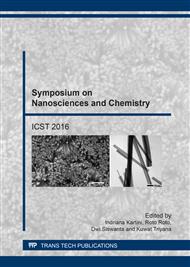p.44
p.50
p.55
p.65
p.69
p.79
p.85
p.91
p.97
Spreading Dynamics of Corrosion on Material Surface Using Site Percolation Model
Abstract:
Spreading phenomenon is usually characterized by existence of two competing processes. On the spreading of corrosion, competition occurs between the power of solution to corrode with the resistance level of a metal surface against corrosion. In the present study, we simulate a corrosion process using site percolation model to determine the spreading pattern of corrosion. The simulation results showed different spreading patterns and dynamics of corrosion when the value of corrode molecules were varied. The simulation results also indicate the emergence of two regimes that happens, smooth regime and random regime. Smooth regime characterized by the shape of its corrosion face is almost the same as before. While random regime characterized by the appearance of random spreading pattern on the shape of corrosion face.
Info:
Periodical:
Pages:
69-75
Citation:
Online since:
July 2017
Authors:
Keywords:
Price:
Сopyright:
© 2017 Trans Tech Publications Ltd. All Rights Reserved
Share:
Citation:


